Nicole schreibt...
Corfu 2017 |
 |
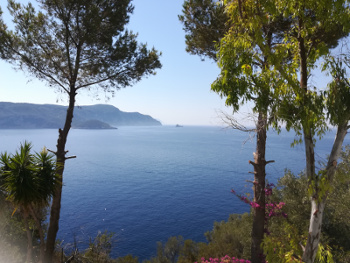 Although Greece is one of my favorite countries, it took me quite a long time to actually return there for a visit. My chosen destination being Corfu, the largest of the Ionian Islands to the Northwest of the Greek mainland. I -had- actually caught a glimpse of Corfu many years ago during that Kafkaesque class trip to Delphi when we travelled by ferry from Ancona via Corfu and Igoumenitsa to Patras, but of course that counts for nothing much at all. So here I was at last on Corfu proper, where I had settled for the small resort Benitses which is both close to some of the island's best sights and has a nice pebbly beach to chill out on.
Reaching Corfu on an evening flight out of Duesseldorf on Condor, there was little else to do but to check into the hotel, go for a stroll up and down the taverna-lined main street of Benitses and turn in early. Next morning was spent on the beach to avoid the morning-onslaught of tour groups on one of Corfu's most famous sights and one of the things I had been most keen on seeing: The Achilleion Palace, slightly less than hour's walk (uphill!) from Benitses.
Although Greece is one of my favorite countries, it took me quite a long time to actually return there for a visit. My chosen destination being Corfu, the largest of the Ionian Islands to the Northwest of the Greek mainland. I -had- actually caught a glimpse of Corfu many years ago during that Kafkaesque class trip to Delphi when we travelled by ferry from Ancona via Corfu and Igoumenitsa to Patras, but of course that counts for nothing much at all. So here I was at last on Corfu proper, where I had settled for the small resort Benitses which is both close to some of the island's best sights and has a nice pebbly beach to chill out on.
Reaching Corfu on an evening flight out of Duesseldorf on Condor, there was little else to do but to check into the hotel, go for a stroll up and down the taverna-lined main street of Benitses and turn in early. Next morning was spent on the beach to avoid the morning-onslaught of tour groups on one of Corfu's most famous sights and one of the things I had been most keen on seeing: The Achilleion Palace, slightly less than hour's walk (uphill!) from Benitses.
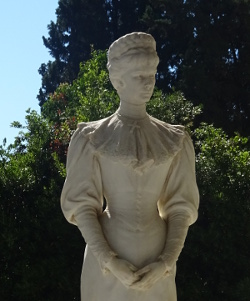
Empress Elisabeth of Austria - looking rather prim here in front of her palace - is best-known today as sappy "Sissi" from the 50s movies and to musical theatre nerds from the musical "Elisabeth" that claims to tell her true story. Definitely true is the fact that she had never been meant to become empress of the vast Habsburg empire while her older sister Helene had been groomed for that position for years. But young Emperor Francis Joseph fell for 16-year old Sisi like a rock and married her instead. While Sisi initially loved her dashing young husband back, she hated court life in Vienna with a passion and grew into a deeply neurotic unhappy woman who spent as much time as she could away from court. One of her favorite places was the island of Corfu where she had the Achilleion built - a modest summer house for an empress, a grand palace for us mere mortals:
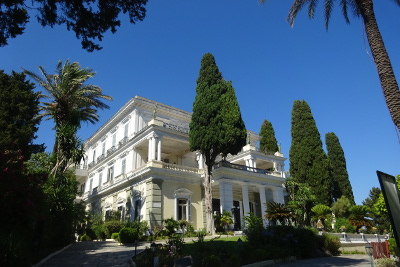
|
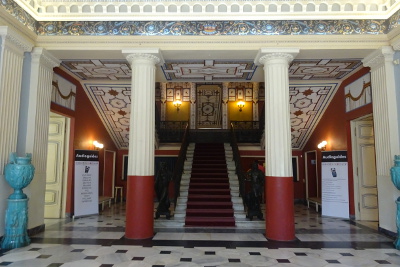 |
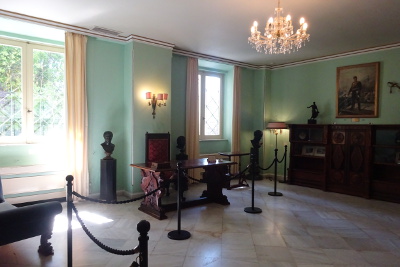
|
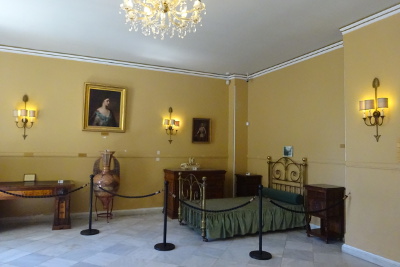 |
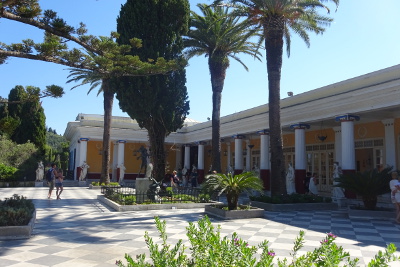
|
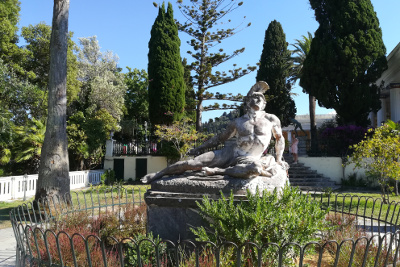 |
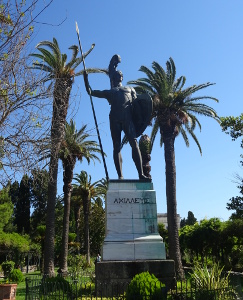 The first and second floors seemed to be reserved for guests and staff, though oddly when you come up to the second floor you step out onto the pretty patio and into the garden. The guide book talks of the Achilleion as built in Pompeiian style, though to me it looked mostly like some fantasy idea of Ancient Greece with the muses lined up in front of marble columns and statues dotted everywhere in the gardens.
Sisi had a thing for the Greek hero Achilles (for whom the whole building is named) and had the statue of the dying tragic Achilles set up in the garden (above right). After her untimely death in 1898 the palace was sold to German Kaiser Wilhelm II. who had -another- Achilles set up at the far end of the garden, this one the tall mighty warrior type. Which says quite a lot about the mindsets of the two inhabitants of the Achilleion. I'm sure both enjoyed the fantastic views in every direction though, which also explained to me at last, why Sisi had chosen this location so far away from the city.
The first and second floors seemed to be reserved for guests and staff, though oddly when you come up to the second floor you step out onto the pretty patio and into the garden. The guide book talks of the Achilleion as built in Pompeiian style, though to me it looked mostly like some fantasy idea of Ancient Greece with the muses lined up in front of marble columns and statues dotted everywhere in the gardens.
Sisi had a thing for the Greek hero Achilles (for whom the whole building is named) and had the statue of the dying tragic Achilles set up in the garden (above right). After her untimely death in 1898 the palace was sold to German Kaiser Wilhelm II. who had -another- Achilles set up at the far end of the garden, this one the tall mighty warrior type. Which says quite a lot about the mindsets of the two inhabitants of the Achilleion. I'm sure both enjoyed the fantastic views in every direction though, which also explained to me at last, why Sisi had chosen this location so far away from the city.
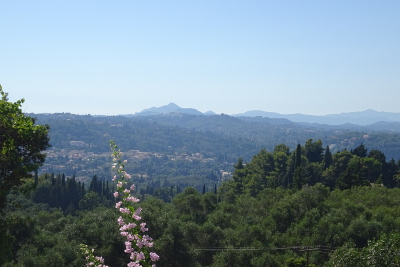
|
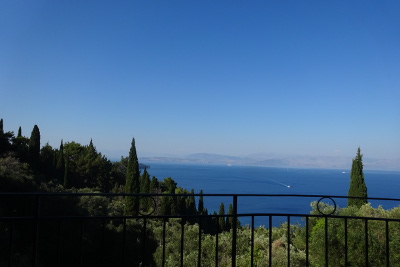 |
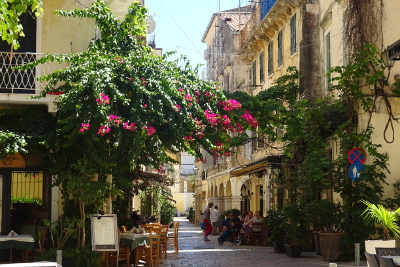 The next day followed the same scheme, with some quiet hours on the beach first to read, chill and dip into the cold Mediterranean until the worst of the day's heat was over. Then it was time for another sightseeing excursion, this one to Corfu City. For this we had to throw ourselves at the mercy of public transport, which functioned pretty much like all Mediterranean public transport functions: "Yes, there will be a bus eventually, but it will come whenever it feels like and most definitely not at the time given in the printed schedule".
Never mind, it did get us to Corfu City eventually and from the terminus it was only a short walk through the lovely Old Town to the Spiadina (Esplanade) by the seaside where the Old Venetian Fortress (Paleo Frourio) looms. Its foundations hark back to 6th century when the expanding Byzantine Empire first set up some defenses on the twin hills by the sea. Which also gave the island its present name because "koryfi" means summit in Greek. The island's other name Kerkyra is much older even, going back to 734 BC when the Corinthians first set up shop here and called their settlement Korkyra. In the medieval period Corfu changed hands several times until the Venetians arrived on the scene in late 14th century and turned the earlier defenses into the mighty fortress still seen today (they also built a second one, the "New" Venetian Fortress on the other side of the Old Town).
The next day followed the same scheme, with some quiet hours on the beach first to read, chill and dip into the cold Mediterranean until the worst of the day's heat was over. Then it was time for another sightseeing excursion, this one to Corfu City. For this we had to throw ourselves at the mercy of public transport, which functioned pretty much like all Mediterranean public transport functions: "Yes, there will be a bus eventually, but it will come whenever it feels like and most definitely not at the time given in the printed schedule".
Never mind, it did get us to Corfu City eventually and from the terminus it was only a short walk through the lovely Old Town to the Spiadina (Esplanade) by the seaside where the Old Venetian Fortress (Paleo Frourio) looms. Its foundations hark back to 6th century when the expanding Byzantine Empire first set up some defenses on the twin hills by the sea. Which also gave the island its present name because "koryfi" means summit in Greek. The island's other name Kerkyra is much older even, going back to 734 BC when the Corinthians first set up shop here and called their settlement Korkyra. In the medieval period Corfu changed hands several times until the Venetians arrived on the scene in late 14th century and turned the earlier defenses into the mighty fortress still seen today (they also built a second one, the "New" Venetian Fortress on the other side of the Old Town).
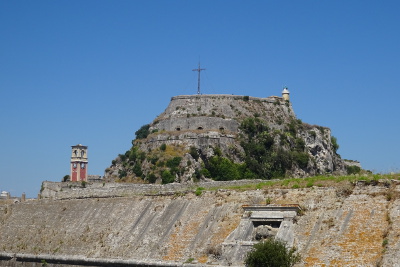
|
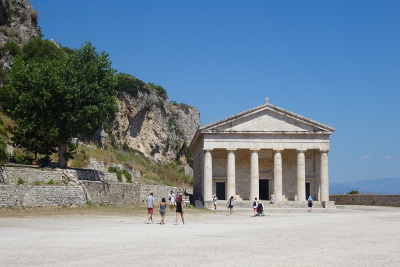 |
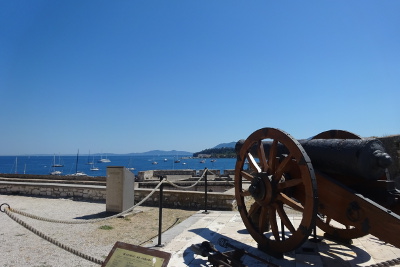
|
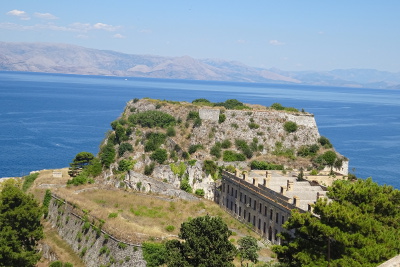 |
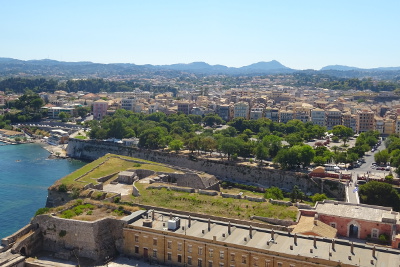
|
 |
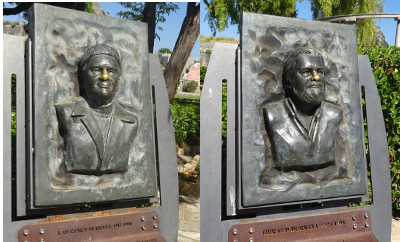 While my love for Greece, Mediterranean history and Sisi's Achilleion had all been reasons enough to visit Corfu, the last nudge I needed came from the lovely British TV series "The Durrells". Adapted from the memoir "My family and other animals" by Gerald Durrell it (vaguely) tells the story of the Durrell Family, mother Louisa and her four children, who move from rainy England to sunny Corfu in the 1930s and spend some years there. Oldest son Lawrence Durrell became a respected writer while youngest son Gerald became an eminent zoologist (who founded the zoo in Jersey later). I was pleased to see that both got a little memorial on the Spiadina (and apparently rubbing their noses is lucky??).
From the Spiadina it's just a short walk past the Palace of St. Michael and St. George, once the seat of the British High Commissioner and now the Museum of Asian Arts, to the Liston. This gorgeous stretch was thought up by Napoleon who had ruled over Corfu for a few years after conquering and dissolving the ancient Republic of Venice (and before being defeated and booted off to St. Helena by the Brits). It's modelled on the Rue de Rivoli in Paris and its shady arches were the perfect place for a lovely dinner in Corfu Town before heading back to Benitses.
While my love for Greece, Mediterranean history and Sisi's Achilleion had all been reasons enough to visit Corfu, the last nudge I needed came from the lovely British TV series "The Durrells". Adapted from the memoir "My family and other animals" by Gerald Durrell it (vaguely) tells the story of the Durrell Family, mother Louisa and her four children, who move from rainy England to sunny Corfu in the 1930s and spend some years there. Oldest son Lawrence Durrell became a respected writer while youngest son Gerald became an eminent zoologist (who founded the zoo in Jersey later). I was pleased to see that both got a little memorial on the Spiadina (and apparently rubbing their noses is lucky??).
From the Spiadina it's just a short walk past the Palace of St. Michael and St. George, once the seat of the British High Commissioner and now the Museum of Asian Arts, to the Liston. This gorgeous stretch was thought up by Napoleon who had ruled over Corfu for a few years after conquering and dissolving the ancient Republic of Venice (and before being defeated and booted off to St. Helena by the Brits). It's modelled on the Rue de Rivoli in Paris and its shady arches were the perfect place for a lovely dinner in Corfu Town before heading back to Benitses.
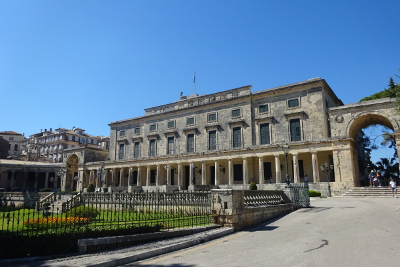
|
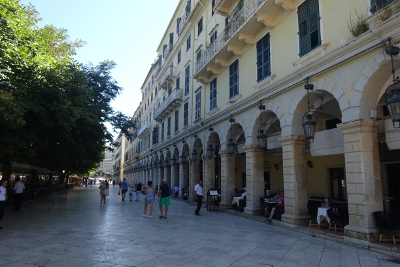 |
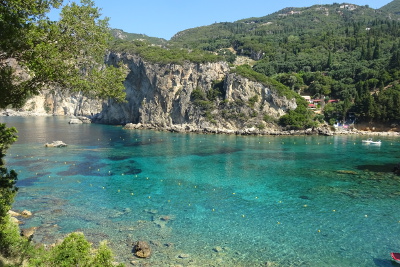 The next day was spent doing nothing at all on the beach with a good book for company and an evening walk to a lovely restaurant built on stilts over the water a little outside town near Kaiser Bridge (which Willy had built so that guests heading for the Achilleion could moor their boats just below the palace and trudge uphill via a long-gone stair case).
But we had one day of sightseeing left and for this we decided to hire a car to get around the island more easily. First stop was the village of Paleokastritsa on the west coast, famed for its beauty. So much so, apparently, that the first British High Commissioner had the first paved road installed on the island in the 1820s to get there more easily. Here are a few pictures of the area with one of the small turquoise bays surrounding the little village and the bigger bays in deepest Mediterranean blue. Simply dreamy!
The next day was spent doing nothing at all on the beach with a good book for company and an evening walk to a lovely restaurant built on stilts over the water a little outside town near Kaiser Bridge (which Willy had built so that guests heading for the Achilleion could moor their boats just below the palace and trudge uphill via a long-gone stair case).
But we had one day of sightseeing left and for this we decided to hire a car to get around the island more easily. First stop was the village of Paleokastritsa on the west coast, famed for its beauty. So much so, apparently, that the first British High Commissioner had the first paved road installed on the island in the 1820s to get there more easily. Here are a few pictures of the area with one of the small turquoise bays surrounding the little village and the bigger bays in deepest Mediterranean blue. Simply dreamy!
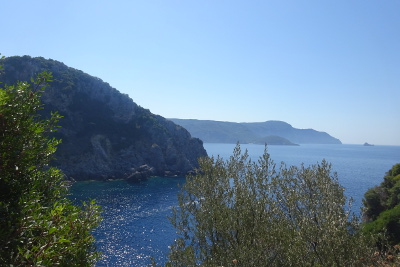
|
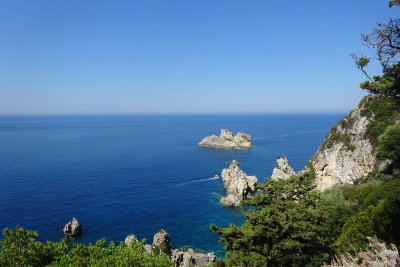 |
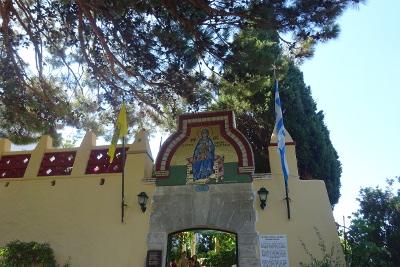
|
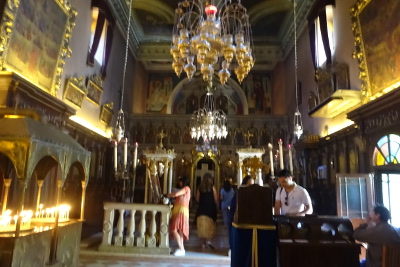 |
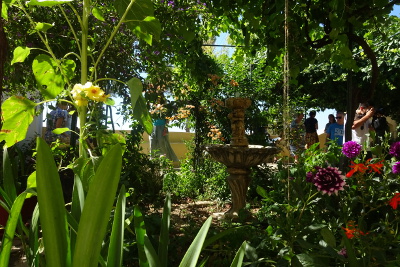
|
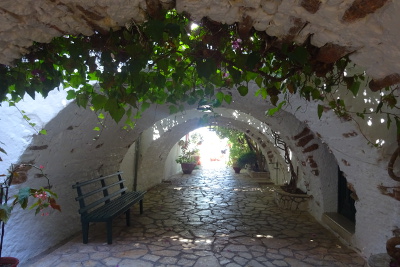 |
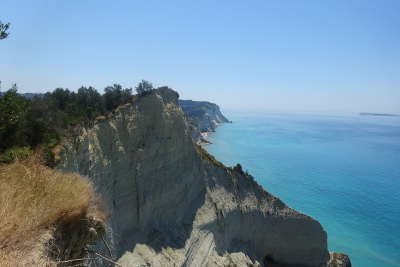
|
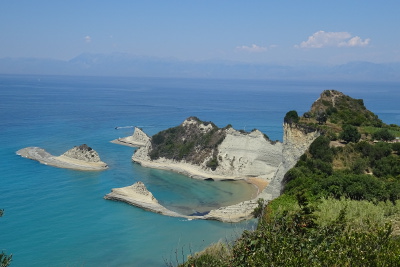 |
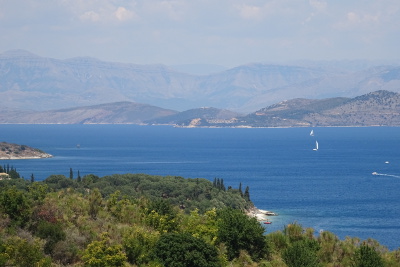 It was also the perfect stop for a longer lunch break, before continueing along the North Coast, passing by the busy resort of Sidari, where I gave up on the idea of trying to find a parking space in the middle of package tourist mayhem to take a look at the famous Canal d'Amour rock formation.
Instead I drove on, all along the north and north east coast with its frequent beautiful views. From the eastern coast it's really just a hop to Albania and while day trips there are possible, it just didn't tickle me enough to sacrifice much-wanted beach time for it. The road passed along the base of Corfu's highest mountain, the Pantokrator (all of 914 metres) and past the resorts of Dassia and Gouvia to end up in the messy suburbs of Corfu-Town where I promptly got lost before finally making my way out again and south to Benitses. It was definitely a day well-spent though, giving me a good idea of the whole island.
It was also the perfect stop for a longer lunch break, before continueing along the North Coast, passing by the busy resort of Sidari, where I gave up on the idea of trying to find a parking space in the middle of package tourist mayhem to take a look at the famous Canal d'Amour rock formation.
Instead I drove on, all along the north and north east coast with its frequent beautiful views. From the eastern coast it's really just a hop to Albania and while day trips there are possible, it just didn't tickle me enough to sacrifice much-wanted beach time for it. The road passed along the base of Corfu's highest mountain, the Pantokrator (all of 914 metres) and past the resorts of Dassia and Gouvia to end up in the messy suburbs of Corfu-Town where I promptly got lost before finally making my way out again and south to Benitses. It was definitely a day well-spent though, giving me a good idea of the whole island.
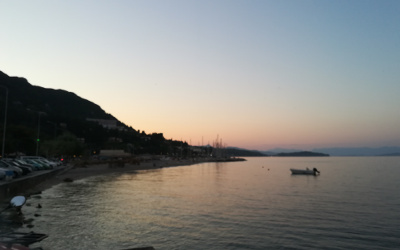
The last day was once again spent on the beach to get some more downtime in before a very early morning departure from Corfu. Overall it was just the kind of break I had needed at this stage and I realized once again (especially by direct comparison to the cruise) that this is really my kind of holiday, a mix of relaxing by a beach or pool, doing some sightseeing in historical places and enjoying some good local food. And while I'm not sure when I'll be back in Greece, I know that I'll definitely be back in the Mediterranean sooner rather than later!
Copyright © All Rights Reserved